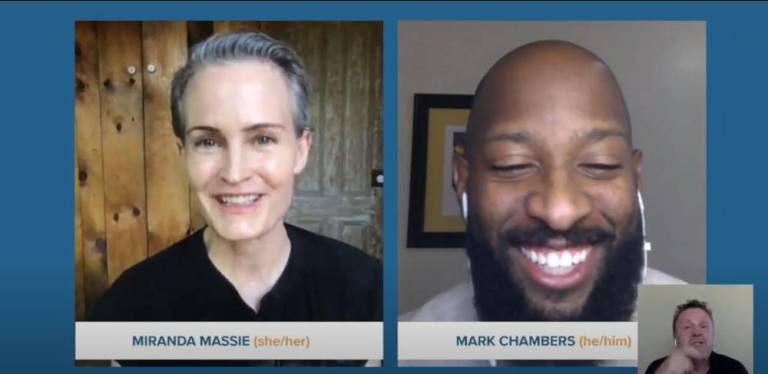The Role of Museums in Stopping Climate Change
A virtual discussion about how design can engage the public on environmental issues

“If you let a good-natured Martian sociologist come down to earth, we and tried to explain to him how we let it get this far ... it would be hard.” That’s Miranda Massie, Director of the Climate Change Museum in Midtown East.
On October 1 she led a discussion, Reimagining Museums for Climate Action, hosted by the Climate Museum, with Mark Chambers, Director of the New York City Mayor’s Office of Sustainability. The discussion was in two parts: a pre-filmed dialogue between Massie and Chambers, followed by a live streamed Q&A with viewers chatting in with questions. The discussion was a part of a series of virtual and some in-person events held during Climate Week.
The Climate Museum was founded in 2015 by Massie, who quit her job as a lawyer to devote herself to the museum. It was the first climate change-focused museum in the US. In this virtual event, the topic at hand was how museums themselves can play a role in curbing climate change.
“You walk into a museum, and there’s a designed grand entrance that tells you what you’re about to see is important,” Chambers said. The goal is for museums to bring that level of importance to the issue of climate change, too. Chambers elaborated that creative people have a way of illustrating to the public issues that need to be seen and help to “demystify” them.
“In the fight to be able to continue having a little more planet, and continue having a place for our species to hang out,” Chambers said, “we have to be putting our attention in the right places.”
“The World is Changing”
Chambers and Massie addressed the severity of climate change as manifested in the wildfires in California. “We’re at a time now of consequences,” he said. “It’s a time in which there’s no longer a place to be where you can ignore that the world is changing around us.”
There are dozens of museums in New York City, some of which focus on specific topics, like the Museum of Ice Cream, the Museum of Food and Drink and the Museum of Sex. Museums provide an official sense to the topic at hand — even for ice cream.
“How can we use our platform as the largest city in the country to be able to make sure we’re drawing attention to the specific needs of other places?” Chambers said.
“Museums retain a lot of public trust in this era of eroded public trust,” Massie said. She and Chambers dove into part of what has eroded public trust: the most recent uprising against racism and police brutality. They discussed how social issues and environmental issues are one in the same.
“A lot of the imbalances and inequity that a lot of us have been experiencing are directly related to the impacts we’re seeing physically,” Chambers said. “Whether it is through seeing that in the disproportionate outcomes of the COVID-19 crisis, or just understanding the fact that we’re in a place where entrenched fossil fuel interests have significantly and deeply entrenched themselves into every decision we make from the phones in our pockets, shoes on our feet.”
Call to Action
Chambers spoke to the responsibility that museums have to weigh in on these issues.
“Museums have got to orient themselves in a way in which they are creating the space for these conversations to happen, and that there never was a history of curation for particular narratives,” he said. “Because again, there’s no room on the sidelines for us not to be using these amazing institutions towards that end.”
Both Massie and Chambers emphasized that the goal of using museums to show the severity of climate change is not a fear tactic, but a call to action.
“At the Climate Museum, we’re constantly talking to people who are worried about the climate crisis, but not yet speaking about it or otherwise taking civic action on it,” Massie said. “One of the reasons for that is that people feel out-scaled by the scope of the climate crisis. That sense of being complicit in the crisis that we’ve faced, that can lead to a kind of paralysis.”
While individual action is extremely important, they spoke to the importance of a cultural shift on the topic of climate change, which can bring about change on a broader level.
“There’s an opportunity, and there’s also a responsibility,” Chambers said, “to use design to be able to reflect where we are right now and where we need to be.”
“Museums retain a lot of public trust in this era of eroded public trust.” Miranda Massie, Director of the Climate Change Museum